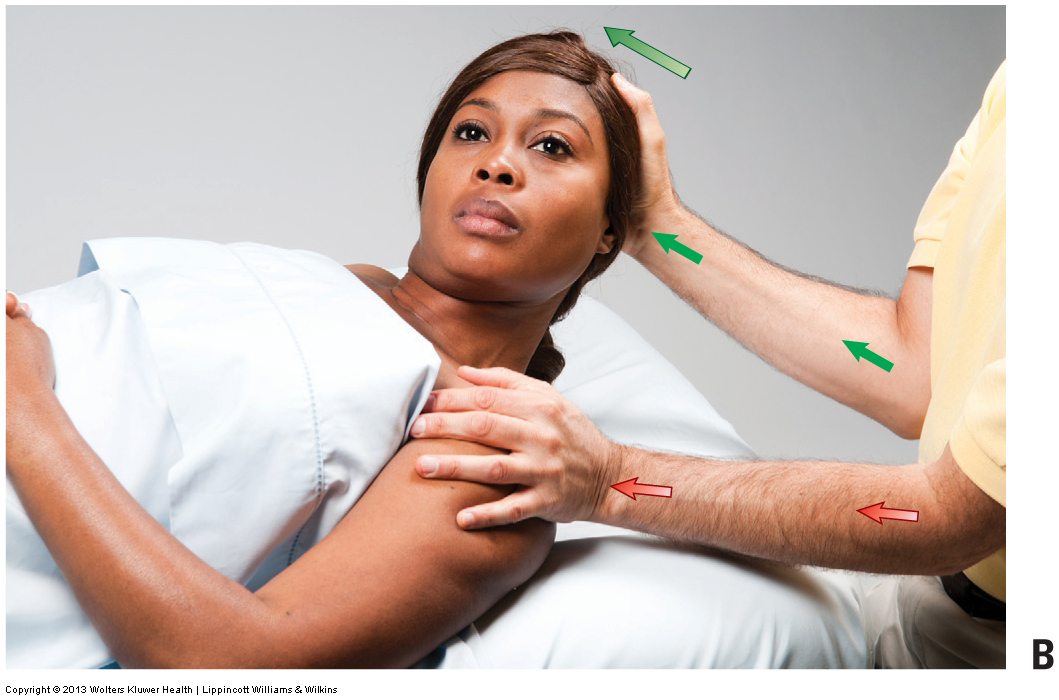Assessment/ Diagnosis

Length assessment (stretch) of the neck into flexion, right lateral flexion, and left rotation for a client with whiplash. Permission: Joseph E. Muscolino. Advanced Treatment Techniques for the Manual Therapist: Neck (2013).
Because a whiplash is essentially a sprain/strain condition, assessment should be done to determine whether the principal damage is muscular strain or ligamentous sprain. This is done using active and passive range of motion (ROM) as well as manual resistance (MR); in each case, pain is considered to be a positive finding. The general rule is that active ROM will be positive for strains and sprains; passive ROM will be positive only for sprains; and manual resistance will be positive only for strains. To assess the client/patient, perform all six ranges of motion actively and passively, and then perform manual resistance for each of the six ranges of motion. The client’s neck should then be assessed in oblique planes to search for restrictions in motion. The difficulty is that if the client’s/patient’s musculature is very tight, as is often the case during the acute stage, the client’s/patient’s range of motion is often so restricted that it is not possible to move the cervical spinal joints to the end of passive range of motion to stress and assess the ligaments. For this reason, sometimes it is necessary to reexamine the client/patient after a few weeks of treatment to accurately assess the extent of the injury/condition.
It can also be helpful to ask the client/patient during the verbal history whether they remember being relaxed during the impact or whether they remember tightening up before the accident occurred, if, for example, they saw the accident coming. As a general rule, if the client’s/patient’s neck muscles were contracted during the impact, the musculature would experience the majority of the impact and a strain would primarily occur. If the client/patient were relaxed during the accident, then the musculature would not be contracting to protect the neck and the ligaments instead would experience the force of the impact. This would lead, if the impact were strong enough, to a ligament sprain. Note: During minor whiplash accidents, if the patient’s/client’s neck is relaxed, very often no tissue damage occurs at all because the soft tissues are relaxed and gently stretch with the motion.
The importance of determining the degree of strain versus sprain is to determine the prognosis for long-term resolution of the whiplash. Muscular strains may cause greater pain initially, but have a greater chance of fully healing. Sprains, on the other hand, tend to result in long-term instability because once ligaments have been overstretched, they tend to remain stretched out and therefore less able to provide stability to the joints. For this reason, sprains also tend to result in chronic muscle tightness to compensate for the decreased joint stability. Whiplash sprains (and strains) may also result in joint dysfunction of the cervical spine, so motion palpation assessment should also be performed.
Regardless of whether the injury is primarily strain or sprain, patients/clients who have experienced a whiplash invariably have muscle tightness in the their neck. Therefore, muscle palpation is important to determine the extent of tightness in each of the muscles as well as the possible presence of myofascial trigger points.
Differential diagnosis/assessment
Differentially assessing a whiplash injury from another condition of the neck is usually not difficult because a whiplash by definition follows a macrotrauma of the neck, most often a car accident. Therefore, verbal history is all that is usually necessary to determine that a client/patient has suffered a whiplash to the neck. When a client/patient does present with a history of a whiplash trauma, what is most important is to determine the exact nature of the injury that was sustained. Did the client/patient only experience a muscle spindle stretch reflex spasm? Did the client/patient experience a strain, sprain, or both? And if both, which one was the principal component of the injury? Does the client/patient have cervical spinal hypermobile joint dysfunction, or perhaps compensatory hypomobile joint dysfunction? Or did the client/patient experience something more serious such as disc pathology with possible nerve impingement or a bone fracture?


